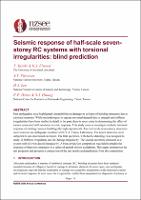| dc.contributor.author | Suzuki, Tomomi | |
| dc.contributor.author | Elwood, Kenneth | |
| dc.contributor.author | Puranam, Aishwarya | |
| dc.contributor.author | Lee, Hung-Jen | |
| dc.contributor.author | Hsiao, Fu-Pei | |
| dc.contributor.author | Hwang, Shyh-Jiann | |
| dc.date.accessioned | 2020-06-18T13:41:50Z | |
| dc.date.available | 2020-06-18T13:41:50Z | |
| dc.date.issued | 2020-04-22 | |
| dc.identifier.uri | https://repo.nzsee.org.nz/xmlui/handle/nzsee/1694 | |
| dc.description.abstract | Past earthquakes have highlighted vulnerabilities to damage or collapse of building structures due to torsional response. While methodologies to capture torsional demand due to strength and stiffness irregularities have been studied in detail in the past, there is uncertainty in determining the effect of torsion associated with nonlinear seismic response. This study aims to investigate inelastic torsional response of existing concrete buildings through experiments. Two half-scale seven-storey structures were tested on an earthquake simulator at NCREE Tainan Laboratory. The tested structures were subjected to uni-directional excitation. The first specimen, with ductile detailing, was designed to study: i) Stiffness irregularity and ii) Damage irregularity. The second specimen simulated as a system with iii) Non-ductile irregularity. A blind prediction competition was held to predict the response of these test structures to a series of ground motion excitations. This paper summarises the test programs and presents a comparison of the test results and predictions from the competition. | |
| dc.language.iso | en | |
| dc.publisher | New Zealand Society for Earthquake Engineering | |
| dc.relation.ispartofseries | 2020;16 | |
| dc.subject | Advances in earthquake engineering research | |
| dc.title | Seismic response of half-scale seven-storey RC systems with torsional irregularities: blind prediction | |
| dc.type | Article | |

